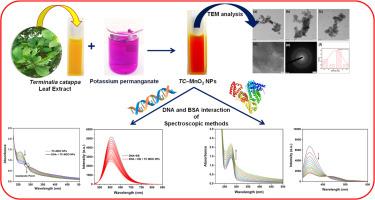石麻叶提取物二氧化锰纳米颗粒的绿色合成、形态表征、抗菌、抗氧化及生物分子相互作用
IF 5.7
3区 材料科学
Q2 MATERIALS SCIENCE, MULTIDISCIPLINARY
引用次数: 0
摘要
本文介绍了一种高效、环保的绿色合成二氧化锰纳米颗粒(TC-MDO NPs)的方法。采用uv -可见、FT-IR、粉末XRD、EDX、SEM和TEM等不同的光谱方法对合成的TC-MDO NPs进行表征。通过紫外可见光谱、红外光谱、粉末XRD和EDX等方法证实了TC-MDO NPs的有效合成。通过扫描电镜和透射电镜分析,证实了该材料的形状为矩形,平均粒径为13 ~ 18 nm。采用琼脂扩散法研究TC-MDO NPs的抗菌和抗真菌活性,采用DPPH自由基清除法测定其抗氧化能力。这些发现表明它具有更好的抗氧化和抗菌潜力。为了深入研究不同DNA/BSA浓度下TC-MDO NPs与DNA/BSA之间的生物界面相互作用,使用了紫外-可见吸收光谱和荧光光谱。根据TC-MDO NPs的物理化学研究,当DNA和牛血清白蛋白与纳米颗粒接触时,会发生明显的结构和构象变化。绿色合成似乎为生产TC-MDO NPs的传统方法提供了一种经济、环保和简单的替代方法。所产生的TC-MDO NPs具有很强的生物活性,可以作为抗菌和抗氧化剂用于治疗。在相关性方面,所有的研究都表明,嵌入接触控制了纳米颗粒与DNA之间的大部分相互作用。这些发现为DNA和TC-MDO NPs的研究提供了关键的基础理解。生物传感、生物成像和治疗应用都依赖于DNA与TC-MDO NPs结合的能力。本文章由计算机程序翻译,如有差异,请以英文原文为准。

Green synthesis, morphological characterization, antimicrobial, antioxidant, biomolecular interaction of manganese dioxide nanoparticles using Terminalia catappa Leaf Extract
The green synthesis of manganese dioxide nanoparticles (TC-MDO NPs) using Terminalia catappa (T. catappa) leaf extract is presented in this work in an effective and environmentally friendly manner. Different spectroscopic methods, including UV–visible, FT-IR, Powder XRD, EDX, SEM and TEM were used to characterise the synthesised TC-MDO NPs. The effective synthesis of TC-MDO NPs was confirmed from the UV-visible and FT-IR spectroscopic, Powder XRD and EDX methods. The rectangle shape was validated by the results of the SEM and TEM techniques with an average particle size of 13–18 nm. The agar diffusion method was used to investigate the antibacterial and antifungal activities of TC-MDO NPs, while the DPPH radical scavenging assay was used to determine their antioxidant capabilities. These findings point to better antioxidant and antimicrobial potential. To thoroughly investigate the biointerfacial interaction between DNA/BSA with TC-MDO NPs at varied DNA/BSA concentrations, UV–vis absorption spectra and fluorescence spectra are used. When DNA and BSA come into contact with nanoparticles, there are noticeable structural and conformational changes, according to physicochemical investigations of TC-MDO NPs. Green synthesis appears to offer a cost-effective, environmentally friendly and simple alternative to traditional ways of producing TC-MDO NPs. The strong bioactivity exhibited by the produced TC-MDO NPs suggests therapeutic usage as an antibacterial and antioxidant. Regarding correlation, all investigations indicated that intercalative contact controls the majority of the interaction between nanoparticles and DNA. The findings provide critical fundamental understanding into the study of DNA and TC-MDO NPs. Biosensing, bioimaging, and therapeutic applications all depend on DNA's ability to bind to TC-MDO NPs.
求助全文
通过发布文献求助,成功后即可免费获取论文全文。
去求助
来源期刊

Materials Research Bulletin
工程技术-材料科学:综合
CiteScore
9.80
自引率
5.60%
发文量
372
审稿时长
42 days
期刊介绍:
Materials Research Bulletin is an international journal reporting high-impact research on processing-structure-property relationships in functional materials and nanomaterials with interesting electronic, magnetic, optical, thermal, mechanical or catalytic properties. Papers purely on thermodynamics or theoretical calculations (e.g., density functional theory) do not fall within the scope of the journal unless they also demonstrate a clear link to physical properties. Topics covered include functional materials (e.g., dielectrics, pyroelectrics, piezoelectrics, ferroelectrics, relaxors, thermoelectrics, etc.); electrochemistry and solid-state ionics (e.g., photovoltaics, batteries, sensors, and fuel cells); nanomaterials, graphene, and nanocomposites; luminescence and photocatalysis; crystal-structure and defect-structure analysis; novel electronics; non-crystalline solids; flexible electronics; protein-material interactions; and polymeric ion-exchange membranes.
 求助内容:
求助内容: 应助结果提醒方式:
应助结果提醒方式:


